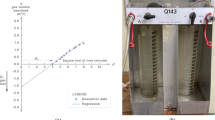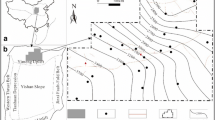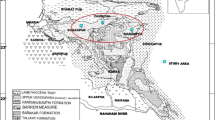Abstract
Undersaturation of coal with respect to gas is a major economic risk in the coal bed gas exploration. This communication addresses the following questions: (1) How much thermogenic gas is formed from coals at different levels of maturity? (2)What is the minimum rank at which a given coal has generated sufficient thermogenic gas to be saturated at reservoir pressure and temperature conditions? (3) What is the effect of uplift on sorption equilibria? (4) What is the role of biogenic gas for coal bed gas saturation? and (5) what is the magnitude of the diffusive gas loss? Results and conclusions of this work do not include coals which are within a conventional gas reservoir. Kinetic compositional modeling results, calibrated with coal-specific data, show that the vitrinite reflectance (Ro) level at which a coal has generated sufficient thermogenic gas to be saturated at reservoir pressure-temperature (PT) conditions varies from less than 0.60% to more than 1.4%. The coals rich in linear aliphatic polymers (LAP) become saturated by self-generated thermogenic gas at reflectance levels below 0.75%. The self-generated gas from coals which are dominated by “humic” aromatic polymers (HAP) does not reach the saturation sorption level, below a vitrinite reflectance of around 0.9–1.2%. The vitrinite-rich coals of Jurassic, Cretaceous and Tertiary age are more likely to have an appreciable contribution from LAP material, than are the coals of Palaeozoic age. Coals which are dominated by semi-inertinites may not become saturated by self-generated gas even at very high ranks (Ro>1.4%). The importance of biogenic gas for saturating a severely undersatu-rated coal is questionable. Very strong biogenic signature is observed in strongly undersaturated coals, which have lost significant amounts of thermogenic gas. Evaluation of sorption (ad- & ab-sorption) and desorption experiments and modeling results indicates that coal can sorb larger quantities of gas in deep basin positions, and those which have generated enough gas to do so, will des-orb gas during uplift. A critical factor which can lead to undersaturation, of an initially saturated coal bed, is diffusive gas loss. The effect of diffusive losses can be significant and should be accounted for in the risk assessment.
Access this chapter
Tax calculation will be finalised at checkout
Purchases are for personal use only
Preview
Unable to display preview. Download preview PDF.
Similar content being viewed by others
References
Blayden, H.E., Gibson, J. and Riley, H.L. (1944) An x-ray study of the structure of coals, cokes and chars. Proceedings Conference on Ultra-fine structures of coals and cokes. British Coal Utilization Research Association, London, 176–231.
Boreham. C.J., Powell, T.G., and Hutton, A.C. (1988) Chemical and petrographic characterization of the Australian Tertiary Duaringa oil shale deposit. Fuel, 67, 1369–1377.
Boreham. C.J., Powell, T.G. (1991) Variation in pyrolysate of sediments from the Jurassic Walloon coal measures, eastern Australia as a function of thermal maturation. Organic Geochemistry, 17, 723–733.
Diamond, R. (1957) X-ray diffraction data for large aromatic molecules. Acta Cryst., 10, 359.
Gregg, S.J., and Sing, K.S.W. (1982) Adsorption, Surface Area and Porosity,Academic Press, 303p.
Franklin, R.E. (1951) Crystallite growth in graphitizing and non-graphitizing carbons. Proceedings of the Royal Society, Series A, 209, 196–218.
Horsfield, B. (1989) Practical criteria for classifying kerogen: Some observations from pyrolysis gas chromatography. Geochimica et Cosmochimica Acta, 53, 891–901.
Kim, A. G. (1977) Estimating methane content of bituminous coalbeds from adsorption data. US Department of the Interior, Bureau of Mines Research Investigation 8245, 1–22.
Khavari-Khorasani, G. (1997) Coal bed methane: gas saturation and cleating properties. Abstracts:1997 MPG Annual Convention, April 97, Dallas.
Khavari-Khorasani, G. and Michelsen, J.K. (1994) The effect of overpressure, lithology, chemistry and heating rate on vitrinite reflectance evolution, and its relationship with oil generation. Australian Petroleum Exploration Association Journal, 418–434.
Khavari-Khorasani, G., Dolson, C., and Michelsen J.K. (1998). The factors controlling the abundance and migration of heavy versus light oils, as constrained by data from the Gulf of Suez—Part I The effect of expelled petroleum composition, PVT and the petroleum system geometry. Organic Geochemistry,23 p. In press.
Khavari-Khorasani and Michelsen, J.K. (1991) Geological and laboratory evidence for early generation of large amounts of liquid hydrocarbons from suberinite and subereous components. Organic Geochemistry, 17, 849–863.
van Krevelen, D.W. (1961) Coal. Amsterdam: Elsevier, 514 p. van Krevelen, D.W. (1993) Coal. Amsterdam: Elsevier, 979 p.
Lamberson, M.N. and Bustin, R.M. (1993) Coalbed methane characteristics of gates formation coals, Northeastern British Columbia: Effect of maceral composition. American Association of Petroleum Geologists Bulletin, 12, 2062–2076.
Larter, S. R. and Sentfle, J.T. (1985) Improved kerogen typing for petroleum source rock analysis. Nature, 318, 277–280.
Milewska-Duda, J, Ceglarska-Stefanska, G., and Duda, J. (1994) A comparison of theoretical and empirical expansion of coals in the high pressure sorption of methane. Fuel, 73, 975–979.
Moffat, D.H. and Weale, K.E. (1955) Sorption by coal of methane at high pressures. Fuel, 34, 449–462.
Reucroft P.J.and Patel H. (1983) Surface area and swellability of coal. Fuel, 62, 279–284. Reucroft P.J.and Patel H.(1986) Gas induced swelling in coal. Fuel, 65, 816–820.
Rice, D.D (1993) Composition and origin of coalbed gas, in B.E. Law and D.D Rice (eds.) Hydrocarbons from coal. AAPG Studies in Geology, 38, 159–184.
Scott, A.D., Kaiser, W.R., and Ayers, W.B. (1991) Composition, distribution and origin of Fruitland Formation and Pictured Cliffs Sandstone gases, San Juan basin, Colorado and New mex-ico, in S.D. Schwochow, D.K. Murray, and M.F. Fahy (eds.) Coalbed methane of western North America, Rocky Mountain Association of Geologists, 93–108.
Scott, A.D., Kaiser, W.R., and Ayers, W.B. (1994) Thermogenic and Biogenic gases, San Juan basin, Colorado and New Mexico–Implications for coalbed producibility. American Association of Petroleum Geologists Bulletin, 78, 8. 1186–1209.
Smith, J.W. and Pallaser, R.J. (1996) Microbial origin of Australian coalbed methane. American Association of Petroleum Geologists Bulletin, 80. 891–897.
Stach, E., Mackowsky, M.Th., Teichmüller, M. taylor, G.H., Chandra, D., and Teichmüller, R. (1982) Stach’s Textbook of Coal Petrology. Gebrüder Borntraeger, Berlin, 535 p.
Standing, M.B. (1950) Volumetric and phase behavior of oil field hydrocarbon systems. Reinhold Publishing Corporation, 123p.
Tang, Y., Jenden, P.D., and Teerman, S.C. (1991) Thermogenic methane formation in low-rank coals—Published models and results from laboratory pyrolysis of lignite. In Manning D. (ed.) Organic Geochemistry Advances and Applications in Energy and the natural Environment,15th Meeting of the European Association of Organic Geochemists. Abstracts, 329–331.
Yee, D., Seidle J.P. and Hanson, W.B. (1993) Gas sorption on coal and measurement of gas content, in B.E. Law and D.D Rice (eds.) Hydrocarbons from coal. AAPG Studies in Geology, 38, 203–218.
Author information
Authors and Affiliations
Editor information
Editors and Affiliations
Rights and permissions
Copyright information
© 1999 Springer Science+Business Media Dordrecht
About this chapter
Cite this chapter
Khavari-Khorasani, G., Michelsen, J.K. (1999). Coal Bed Gas Content and Gas Undersaturation. In: Mastalerz, M., Glikson, M., Golding, S.D. (eds) Coalbed Methane: Scientific, Environmental and Economic Evaluation. Springer, Dordrecht. https://doi.org/10.1007/978-94-017-1062-6_13
Download citation
DOI: https://doi.org/10.1007/978-94-017-1062-6_13
Publisher Name: Springer, Dordrecht
Print ISBN: 978-90-481-5217-9
Online ISBN: 978-94-017-1062-6
eBook Packages: Springer Book Archive




